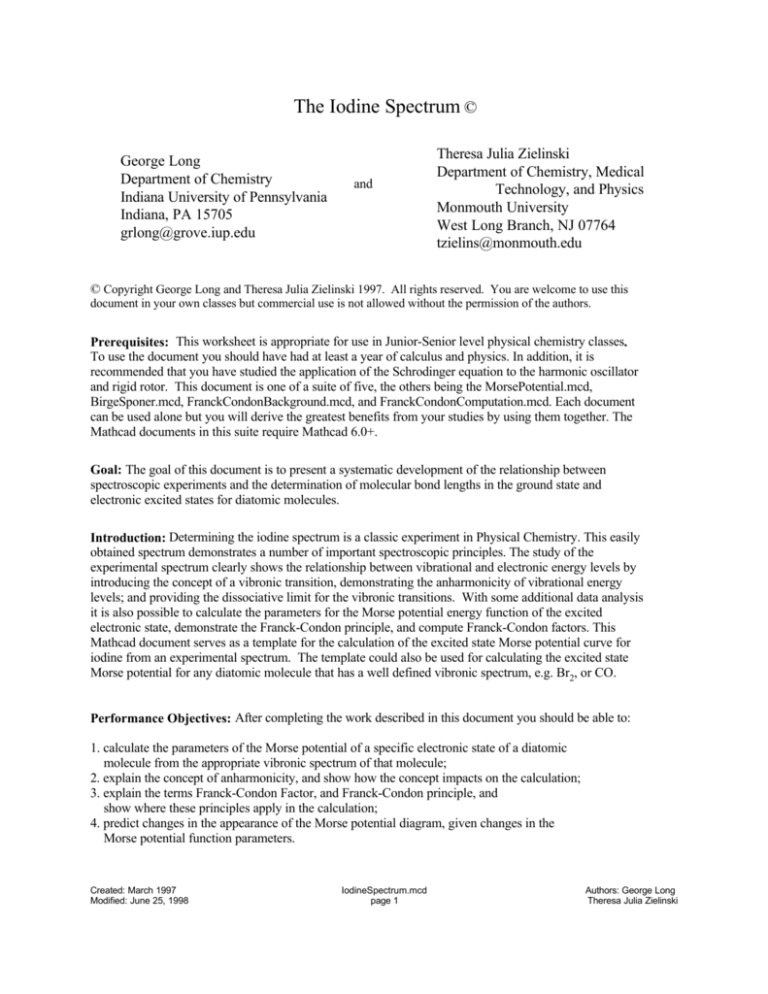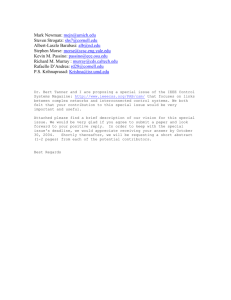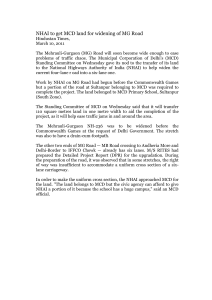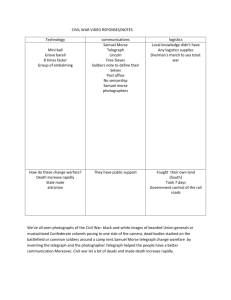
The Iodine Spectrum ©
George Long
Department of Chemistry
Indiana University of Pennsylvania
Indiana, PA 15705
grlong@grove.iup.edu
and
Theresa Julia Zielinski
Department of Chemistry, Medical
Technology, and Physics
Monmouth University
West Long Branch, NJ 07764
tzielins@monmouth.edu
© Copyright George Long and Theresa Julia Zielinski 1997. All rights reserved. You are welcome to use this
document in your own classes but commercial use is not allowed without the permission of the authors.
Prerequisites: This worksheet is appropriate for use in Junior-Senior level physical chemistry classes.
To use the document you should have had at least a year of calculus and physics. In addition, it is
recommended that you have studied the application of the Schrodinger equation to the harmonic oscillator
and rigid rotor. This document is one of a suite of five, the others being the MorsePotential.mcd,
BirgeSponer.mcd, FranckCondonBackground.mcd, and FranckCondonComputation.mcd. Each document
can be used alone but you will derive the greatest benefits from your studies by using them together. The
Mathcad documents in this suite require Mathcad 6.0+.
Goal: The goal of this document is to present a systematic development of the relationship between
spectroscopic experiments and the determination of molecular bond lengths in the ground state and
electronic excited states for diatomic molecules.
Introduction: Determining the iodine spectrum is a classic experiment in Physical Chemistry. This easily
obtained spectrum demonstrates a number of important spectroscopic principles. The study of the
experimental spectrum clearly shows the relationship between vibrational and electronic energy levels by
introducing the concept of a vibronic transition, demonstrating the anharmonicity of vibrational energy
levels; and providing the dissociative limit for the vibronic transitions. With some additional data analysis
it is also possible to calculate the parameters for the Morse potential energy function of the excited
electronic state, demonstrate the Franck-Condon principle, and compute Franck-Condon factors. This
Mathcad document serves as a template for the calculation of the excited state Morse potential curve for
iodine from an experimental spectrum. The template could also be used for calculating the excited state
Morse potential for any diatomic molecule that has a well defined vibronic spectrum, e.g. Br2, or CO.
Performance Objectives: After completing the work described in this document you should be able to:
1. calculate the parameters of the Morse potential of a specific electronic state of a diatomic
molecule from the appropriate vibronic spectrum of that molecule;
2. explain the concept of anharmonicity, and show how the concept impacts on the calculation;
3. explain the terms Franck-Condon Factor, and Franck-Condon principle, and
show where these principles apply in the calculation;
4. predict changes in the appearance of the Morse potential diagram, given changes in the
Morse potential function parameters.
Created: March 1997
Modified: June 25, 1998
IodineSpectrum.mcd
page 1
Authors: George Long
Theresa Julia Zielinski
Part 1. Preliminaries
In this introduction we examine typical student data obtained from a UV-vis iodine spectrum. This set of
data contains 30 peaks listed in the column vector ν. These transitions have been identified as emanating
from the ground vibronic state of iodine. The analysis of the student data shown here sets the stage for
the determination of the spectroscopic properties and equilibrium bond length for the excited state of
iodine that the student observed in the spectrum.
i
0 .. 29
ν
Vi
Vi
19586.9
19552.3
19504.8
19465.9
19418.3
19375.1
19323.2
19275.7
19223.8
19167.6
19111.4
19050.9
18990.4
18925.6
18860.7
18795.9
18722.4
18653.3
18579.8
18506.3
18428.5
18342.1
18259.9
18177.8
18091.5
17996.3
17909.8
17814.8
17719.7
17624.6
Created: March 1997
Modified: June 25, 1998
47
i
The vibrational quantum numbers for the excited electronic states,
Vi , are identified by the array index i. Here we use the fact that the
line closest to 542.1 nm (18428 cm-1) is assigned quantum number
V = 27. (Later we will use v for the vibrational quantum number.)
This assignment of quantum number 27 comes from the literature
(Sime p 668), and was determined using high resolution
spectroscopy that allowed identification of the transitions down to
that for the V=0 quantum state. All spectral lines are
unambiguously labeled relative to this one. The V=27 line is not the
first line in the list to the left; since it is the 10th we subtract 10 and
add 30 to obtain the upper limit, 47 in this case. (Remember, there
are 30 items in the list identified by the index i.) In space to the
right ask Mathcad to show the contents of the vectors i, Vi
and 47-i. Verify that in the the vector 47-i the 27th entry is
associated with the peak at 18428cm-1. Note how the indices
vary. What happens to the numbering of the energy levels
when we use 47-i?
What is the range of vibrational quantum numbers for the
frequencies observed in the spectral data given here? What
vibrational energy level of the ground state is the origin of
each observed transition given here? Hint: consider the state
of I2 in your sample.
Now that the peaks are assigned we can plot frequency versus
quantum number. The curvature in the plot shows the
anharmonicity of the vibration and it also allows the estimation
of the 0 - 0 vibronic transition by extrapolation to V = 0. The
curvature of the line does not affect the calculation of the Morse
potential that will be done later.
Recognizing that the observed vibronic transitions disappear at
the dissociation limit, the point where the spectrum becomes
continuous, permits us to calculate the dissociation energy Do
from the vibronic spectrum of a diatomic molecule. We will use
a Birge-Sponer plot to do this. We discuss the Birge-Sponer plot
in the next section of this document.
IodineSpectrum.mcd
page 2
Authors: George Long
Theresa Julia Zielinski
transition frequncy
2 104
4
1.9 10
ν V
i
4
1.8 10
1.7 104
15
20
25
30
35
40
45
50
V
i
Vibrational quantum state
Questions for Part 1.
1. What would this plot look like if the vibration were harmonic?
2. How accurate do you think your value for the energy of the electronic transition is?
Hint: calculate a ∆E for the 0-0 transition.
Created: March 1997
Modified: June 25, 1998
IodineSpectrum.mcd
page 3
Authors: George Long
Theresa Julia Zielinski
Part 2. The Birge-Sponer Plot
You can calculate the dissociation energy, Do, the anharmonicity constant, ωeχe, and the vibrational
constant, ωe, from the Birge-Sponer plot. The derivation of the Birge-Spooner equations is available in
the companion Mathcad document, BirgeSponer.mcd. For specific definitions of the dissociation
energies D o, and De and other properties of the Morse potential see the companion document
MorsePotential.mcd. Additional information can be found in the references at the end of this
document especially the papers by Lessinger and McNaught.
In a typical Birge-Sponer plot, you graph the energy difference between the successive spectral bands
as a function of the vibrational quantum number of the band plus one, i.e. v+1. Notice how indices
are used to accomplish this here.
i
qi
46
v
∆ν
q
We can't include the highest and lowest frequencies because we
will be subtracting neighboring pairs of frequencies.
46 .. 19
i
q
i
1
Mathcad note: we changed the quantum number variable name
here. V above on page 2 was an index variable name. Here it is the
name of a vector. .
1.
i
qi is the index that labels the frequency difference vector in
ascending order. Check this by displaying the array qi. The
same array index is used for the quantum numbers.
i
2
νi
1
νi
1
. cm
1
Compute the difference in the frequency between neighboring
vibrational states using Equation 4 from BirgeSponer.mcd.
Check the index, quantum numbers and frequency differences at this point by
displaying the various vectors in space at the right. Note how the index change
permits plotting of the frequencies in correct order with the correct quantum
number. You may need to change the numerical format display precision to show
sufficient digits for computation of ∆ν . Check, by hand, some of the entries of
these vectors to be sure you understand how they arise.
m1
slope( v, ∆ν )
m1 = 210.409 m
ωe
Determine the slope and the intercept of the Birge-Sponer
plot. ωe is the intercept from the Birge-Sponer plot. Notice
the use of the slope and intercept functions of Mathcad.
The Birge-Sponer plot appears below.
1
intercept( v , ∆ν )
4
ωe = 1.383 10
j
m
1
0 .. 64
fit( j )
Created: March 1997
Modified: June 25, 1998
( m1. j
ωe )
fit(j) is the straight line using the slope and intercept
of the Birge-Sponer plot.
IodineSpectrum.mcd
page 4
Authors: George Long
Theresa Julia Zielinski
Birge-Sponer Plot
1.5 104
1 10
∆ν q
i
4
fit( j )
5000
0
0
10
20
30
40
50
60
70
v q ,j
i
ωeχe
m1
2
ωe = 138.253 cm
1
ωeχe = 1.052 cm
1
ωe is the vibrational constant for the excited state while χeωe is the
anharmonicity constant for the excited state.
The x intercept tells you the number of quantum states prior to dissociation as
well as the limits for integration used in the calculation of the dissociation
energy. Explain how the x intercept is obtained. This is a good time to go
back and look at the BirgeSponer.mcd document again. Here we use
equation 3 from BirgeSponer.mcd in the plot above. The ∆ν of this
document was called ∆G(v') in equation 3 in BirgeSponer.mcd.
ωe
2 . ωeχe
1 = 64.707
Here we use equation 7 from the BirgeSponer.mcd
document to compute vmax.
Thus there are 65 quantum states before dissociation.
Created: March 1997
Modified: June 25, 1998
IodineSpectrum.mcd
page 5
Authors: George Long
Theresa Julia Zielinski
The area under the Birge-Sponer plot is the dissociation energy, Do , of the excited state of the
molecule. You can calculate this dissociation energy by integrating the function of the line fit to the
data. Here Mathcad does the integration numerically, however, the definite integral of the straight
line function can be used instead.
66
Do
fit( j ) dj
3
Do = 4.542 10
cm
1
0
De
Do
ωe
2
3
De = 4.611 10
cm
1
Notice that Do and De differ by the zero point
energy of the excited state.
Questions for Part 2:
1. How do the computed Do and De values compare to literature values ?
2. What experimental parameters affect the accuracy of the computed dissociation
energy values ?
3. How accurate a result is possible using your spectrophotometer ?
4. What type of equipment would you need to determine the dissociation energies
more accurately ?
Created: March 1997
Modified: June 25, 1998
IodineSpectrum.mcd
page 6
Authors: George Long
Theresa Julia Zielinski
Part 3. Calculation of the Morse potential anharmonicity constant β
The Morse potential is a relatively simple function that is used to model the potential energy of
a diatomic molecule as a function of internuclear distance. The Morse potential
U( r )
D e. 1
e
β. r R e
2
is defined by three physical constants.
These are De , the dissociation energy (not to be confused with Do), Re , the equilibrium
internuclear distance, and β, the Morse anharmonicity coefficient (not to be confused with the
anharmonicity constant ωeχe). For more information concerning these constants and their
significance see the companion document, MorsePotential.mcd, where hands on practice with
the Morse potential will give you a greater appreciation of the function.
First we calculate β, for the excited state of iodine. Start by defining some constants.
Ang
c
10
10.
define the unit for angstroms
m
8
2.998. 10 . m. sec
1
the speed of light
note that π is predefined by Mathcad
π = 3.142
h
6.6261 . 10
µ
1.053. 10
34.
25.
joule. sec
kg
Planck's constant
the reduced mass of iodine
Calculate β using the following equation. Notice how Mathcad made the proper unit conversions.
When you do the calculation by hand it is important to note that all quantities must be in SI units
(kg, m, sec, joules). The cm-1 is not an SI unit.
β
2
2 . π . µ. c .
ωe
De. h
10
β = 1.974 10
m
1
Exercise: Have Mathcad display cm-1
as the units for β .
Questions for Part 3:
1. From where does the equation for β come?
Derive this equation from the Morse potential.
2. With what property of a bond is β associated?
3. Verify that the unit for β is m-1.
Created: March 1997
Modified: June 25, 1998
IodineSpectrum.mcd
page 7
Authors: George Long
Theresa Julia Zielinski
Part 4. Calculating the internuclear distance (Re ) of the excited state.
To calculate Re for the excited state of I2 we need two more pieces of data. First, we need the
frequency of the maximum absorbance of the spectrum, and we need the equilibrium bond length,
Re , for the ground state. The frequency with the maximum absorbance can be determined from
the spectrum. Although Re can be obtained from the fluorescence spectrum, it is usually given to
students for the data analysis in the typical iodine experiment conducted in most physical
chemistry undergraduate laboratories.
Amax
18860.7 . cm
Te
15300 . cm
R1
2.66. 10
1
Frequency of the maximum absorbance from inspection of the spectrum.
1
10.
Frequency of the 0 - 0 or ground state to ground state transition determined
from the data or obtained from the literature.
the equilibrium bond length for the ground state as found in the literature
m
From the Franck-Condon principle, we know that the maximum absorbance will take place where
there is the greatest overlap between an upper state wave function with vibrational quantum number
v' and ground state vibrational wave function with quantum number v''=0. The magnitude of the
overlap is given by the Franck-Condon factors (see the companion documents
FranckCondonBackground.mcd and FranckCondonComputation.mcd for an in depth introduction to
Franck-Condon factors). At the maximum absorbance the value of r in the excited state equals R1,
the equilibrium bond length of the ground state. So, if we know the energy of this transition, we
can use the Morse potential equation to solve for the equilibrium bond length (Re in the notation used
here) of the excited state. The Morse potential energy function is:
U( r )
Te
De. 1
e
β. r R e
2
Substitute R1 for the bond length of the excited state at the moment of the electronic transition, i.e.
R1 = r, and Amax for U(r). When you do this you get:
Amax Te
De. 1
e
β. R1
Re
2
Rearrange the equation to solve for Re. The result is:
Re
R1
1.
β
R e = 2.979 10
Created: March 1997
Modified: June 25, 1998
Amax
ln 1
De
10
m
Te
The solution actually has 2 roots. The larger root is
chosen because Re, the bond length in the excited
state, must be greater than R1, the bond length of the
ground state, for iodine.
Question: What spectroscopic observation would
tell us which root to choose in the calculation here?
IodineSpectrum.mcd
page 8
Authors: George Long
Theresa Julia Zielinski
Exercise: Use Morse potential diagrams to illustrate Franck-Condon Factors, and explain
the appearance of a maximum absorbance.
Question: What are the units of Amax? Is this an energy unit?
Finally, we can plot the Morse potentials of both the ground (X) state and the (B) excited state
potentials in one figure. The plot below shows both.
i
0 .. 500
ri
( .5
i. .01 ) . Ang
4398. cm
groundDe
1.873
βg
}
} this defines the values of r in terms of the array index, i
}
1
Rg e
Ang
}
} ground state parameters, from the literature
}
2.66. Ang
Now calculate the potential energy using the Morse potential function.
Excited "B" State
Bi
De. 1
e
Ground "X" State
β. ri
Re
2
Xi
Te
groundDe. 1
e
βg. ri
Rg e
2
Potential energy curves
2 106
Bi
X
i
1 106
0
2
2.5
3
3.5
4
4.5
5
10
r . 10
i
Excited (B) State
Ground (X) state
Created: March 1997
Modified: June 25, 1998
IodineSpectrum.mcd
page 9
Authors: George Long
Theresa Julia Zielinski
General Questions.
1. Vary the value of the β in the Morse potential equation. How does the value
of β affect the shape of the Morse potential? Do the same for Re, and De. Record
your observations in your notebook.
2. Will obtaining a different frequency for the maximum absorbance make a big
difference in the computed parameters? Change your value for Amax and report
what happens to the computed Morse parameters. Explain your results.
3. Under what conditions would you obtain a different Amax value? Why?
3. Does any other one datum make a significant difference in the calculations? Discuss
the accuracy of your results based on the computational manipulations performed in
this document.
Mastery Exercise:
Obtain the UV-vis spectrum for some other diatomic molecule. Use this document as a template for
constructing the data analysis for the molecule. Compare and contrast the spectroscopic properties of
the iodine molecule to the other molecule you chose. Discuss the differences between the molecules with
respect to their chemical and physical properties.
Acknowledgment:
The authors thank George M. Shalhoub, LaSalle University, for the index scheme used in
the Birge Sponer plot.
References:
1. Sime, R. J., "Physical Chemistry, Methods, Techniques, and Experiments", Saunders
College: Philadelphia, 1990; pp 660-668. (The analysis method in this document generally
follows that outlined in this text.)
2. Snadden, R.B., "The Iodine Spectrum Revisited", J. Chem. Educ. 1987, 64, 919-1921.
3. D'alterio, R, Mattson, R., Harris, R., "Potential Curves for the I2 Molecule: An Undergraduate
Physical Chemistry Experiment", J. Chem. Educ. 1974, 51, 282-284.
4. Lessinger, L., "Morse Oscillators, Birge-Sponer Extrapolation, and the Electronic
Absorption Spectrum of I2", J. Chem. Educ. 1994, 71, 388-391.
5. McNaught, I. J., "The Electronic Spectrum of Iodine Revisited",
J. Chem. Educ. 1980, 57, 101-105.
6. Verma, R. D., "Ultraviolet Spectrum of the Iodine Molecule",
J. Chem. Phys. 1960, 32, 738-749. (this paper gives an excellent set of data for Iodine
and a good figure (Figure 9) for the ground state potential energy function compared to the
Morse potential. The inadequacy of the Morse potential at larger interatomic separations is
clear. The failure of the Morse potential at internuclear separations one Angstrom greater
than the equilibrium bond length is attributed to London forces. These are more commonly
called van der Waals forces and they follow a 1/r6 function rather than the exponential
function given by the Morse potential.)
Created: March 1997
Modified: June 25, 1998
IodineSpectrum.mcd
page 10
Authors: George Long
Theresa Julia Zielinski








